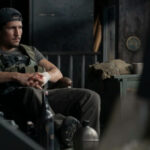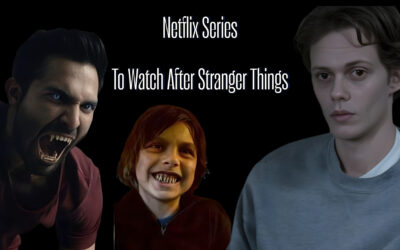 Third Time’s A Charm
Third Time’s A Charm
Hey, weren’t you in Jaws 3? Why do they make shit like that?” — Fan to Dennis Quaid, star of Jaws 3D
I’m going to say that while Jaws 3 is a bad film, it is not totally Cynema. The third shark film was planned as a spoof called Jaws 3, People 0. A script written by National Lampoon’s Vacation Matty Simmons and 16 Candles, Breakfast Club teen king John Hughes exists online. It was to be directed by Jaws ripoff artist Joe Dante of the cult film Piranha (remade as the fun Piranha 3D. How things have come full circle).
When the producers of Jaws and Jaws 2, Richard Zanuck and David Brown were approached by Universal to produce a spoof as a third installment, they declined. “It would have been like fouling your own nest,” Brown said. Universal went forward anyway.
According to the Jaws 3D.com blog, director Joe Alves revealed how he came on board.
“…I came back to Hollywood and Verna Fields (the Oscar-winning film editor of “Jaws,” later an executive at Universal) called me and said, “you know, they’re doing “Jaws 3″ and they’re making a mess. They’ve got a dumb script and Zanuck/Brown don’t want anything to do with it. I really think you should get involved. They’ve got a TV producer who bought the rights doing it.”
Jaws 3D walks a fine line between Cynema and Ed Wood filmmaking. One of the requirements for Cynema is that a project must be made by a majority of people who know better. It also requires that the film is relatively devoid of any fun or loving passion to offset a cynical money grab by the production company. Jaws 3D keeps a foot (fin?) in both worlds and Alves revealed how a 3D concept came about.
“…while we were at a park in Florida we saw an exhibit of underwater 3-D photography. And I just loved it, the depth of it. It really bothered me that we were doing a “3.” There weren’t really a lot of “3’s” out there, maybe “Rocky III,” people weren’t as gracious to sequels at that time, which has really changed in recent years. Then it just hit me…JAWS…3…D.”
 Intent
Intent
I Am Legend author Richard Matheson turned in a story that was eviscerated by Cynema script doctors and turned into a script that bore no resemblance to Matheson’s original work. He said this about his experience with Jaws 3D.
“I’m a good storyteller and I wrote a good outline and a good script. And if they had done it right and if it had been directed by somebody who knew how to direct, I think it would have been an excellent movie. Jaws 3-D was the only thing Joe Alves ever directed; the man is a very skilled production designer, but as a director, no. And the so-called 3-D just made the film look murky – it had no effect whatsoever. It was a waste of time.”
I do not believe director Joe Alves set out to make a bad film. I think he had all the best of intentions. From all accounts he is a superb production designer and nice man. However, Jaws 3D was made to squeeze a few more bucks out of a film series that was never intended to be a franchise. From the first teaser (click here) to the cheesy, carnival-esque poster that screams “All New! All New!” the warning signs were there.
Then on opening night, fears were confirmed. The first film opened with the iconic attack on the skinny dipper. The sequel served up two divers exploring the wreck of the Orca. Jaws 3D gave us a large grouper bit in half with its still moving mouth floating out into the audience via the magic of 3D (see it here).
Apparently never having heard of overkill, the words of the title are also split horizontally in two, and come crashing together like teeth. And that’s all in about the film’s first minute and a half.- Reviewer Ken Begg, Jabootu’s Bad Movie Dimension on Jaws 3
Trouble Signs
 The Opening: Awful red and orange credits rise up out of the screen with streaming tracers behind them (click). The “uh oh” opening credit was: “Shark Theme by John Williams”.
The Opening: Awful red and orange credits rise up out of the screen with streaming tracers behind them (click). The “uh oh” opening credit was: “Shark Theme by John Williams”.
Dennis Quaid and Bess Armstrong: Roy Scheider and Lorraine Gary were the leading couple in the previous films. Quaid and Armstrong are good actors but the dialogue they’re forced to speak makes them look embarrassed.
 Louis Gossett, Jr. Gossett won the Oscar for his performance in An Officer and a Gentleman. He committed to Jaws 3D way before he knew he was getting an Oscar. However we were led to believe this shark film had chops because it nabbed an Oscar winning actor and he wouldn’t go from winning an Oscar to a crappy Jaws movie, would he? (Ask Michael Caine)
Louis Gossett, Jr. Gossett won the Oscar for his performance in An Officer and a Gentleman. He committed to Jaws 3D way before he knew he was getting an Oscar. However we were led to believe this shark film had chops because it nabbed an Oscar winning actor and he wouldn’t go from winning an Oscar to a crappy Jaws movie, would he? (Ask Michael Caine)
 Bringing Back the Brody’s Not only do their ages fluctuate from Jaws and Jaws 2, Dennis Quaid and John Putch look nothing like the kids who played brothers Mike and Sean Brody in the previous films. Putch gives it his best and the kitchen breakfast scene between Putch, Quaid and Armstrong hints at a better film that could have been. These three have chemistry and are genuinely likable actors and characters and…ultimately wasted.
Bringing Back the Brody’s Not only do their ages fluctuate from Jaws and Jaws 2, Dennis Quaid and John Putch look nothing like the kids who played brothers Mike and Sean Brody in the previous films. Putch gives it his best and the kitchen breakfast scene between Putch, Quaid and Armstrong hints at a better film that could have been. These three have chemistry and are genuinely likable actors and characters and…ultimately wasted.
This time around the film takes place at Sea World in Florida. Aside from the fact that Sea World is landlocked, the audience is expected to believe that the Brody family has yet another run in with a Great White shark. Jaws the Revenge will take this concept and run with it.
“Jaws The Revenge was The 4th movie. Revenge didn’t have anything to do with the shark’s activity. It was just a mean shark.” – Joe Alves
The filmmakers considered making the shark in this installment the same shark from Jaws 2. This shows the consideration for quality at the start of pre-production and why the original idea of a spoof was the better one. The second shark had been effectively fried after biting into a power cable that energized Amity Island.
Aftermath
In an article in Fangoria magazine director Joe Alves stated they decided to go with a new shark because the idea of bringing back the electrocuted second beast would have resulted in the film being “laughed out of the theaters.”
When asked by ESPN in their interview 10 Burning Questions for Dennis Quaid, the actor was asked which of his films he considered the worst. “Jaws 3,” he replied. When asked why, Quaid said: “It’s Jaws. Sharks. In 3D. But it’s my son’s favorite. He hauls it out about every month or so.” When asked if Quaid watches it with his son, he simply said, “No.”
Not only is this the biggest fish in the series (35 feet) it also growls and snarls (they have no vocal cords) and swims backwards out of a filtration pipe (sharks can’t swim in reverse and Great Whites can’t be stationary or they will drown). When Simon (“Manimal”) MacCorkindale goes into the filtration pipe to lure the shark in, his cotton rope conveniently snaps giving us the second most ridiculous scene in the film: an inside view from the shark’s gullet of MacCorkindale devoured whole. See it here.
The baby shark isn’t free of criticism either. After chasing Bess and Dennis it rams nose first into a lowered gate and we clearly see, in glorious 3D, the mechanical beast crunches up like a kids’ collapsible cup.
“I guarantee, that in the first two minutes of the movie we’ll get a scream from the audience and then applause.” – Jaws 3D producer Alan Landsburg on the floating fish head opening.
A Lot of Bad Luck
The film’s effects were shopped out to a lower quality effects company. There are several blue screen matte effects that were left in the film unfinished or refined. From a Godzilla-esque toy submarine scene to an underwater tunnel shot where people scream at the sight of the shark, and yet the blank unfinished background is all we see. This shows the blatant disregard of the filmmakers for the audience. The film just gave up trying and that is Cynema. Ed Wood used toys, Styrofoam plates and hubcaps for his alien spaceships but was trying his best. His “effects shop” was his living room with a budget of a few hundred dollars. The effects budget on Jaws 3D was over ten million.
We tried very hard to make it a ‘people’ picture. – Director Joe Alves
One of the worst visual effects shots ever put to screen in a big budget movie is saved for last: the shark’s attack on the control center beneath Sea World. Armstrong and Quaid scream in slow motion as they watched an immobile toy shark swiped from the Sea World souvenir shop glide toward the giant window. Its tail never moves–just slowly gliding toward the camera, never gaining in size as apparently 3D screws with depth perception. Glass suddenly shatters and well, it looked like this.
Lansburg pulled the plug on electronic compositing the very day that shot was scheduled to be completed. When that scene was shot, it was with a combination of a rear-lit screen and front-lit cloth. We told them at the time that it would be a real bitch to pull a film optical because the level of green are different. – David Hogan, Jaws 3D Effects Designer
Just when you thought it couldn’t get any worse, the shark is killed by a yellow grenade still in the dead hand of Simon MacCorkindale — half of his body is sticking out of the shark’s throat while it’s wedged in the control room tower. The open space around the fish shows it could pull free. If it was able to reverse out of a giant filtration pipe, why is a broken window giving a four ton, 35 foot living locomotive trouble?
After seeing this in theatres in 1983, a patron exiting ahead said, “That was pretty good.” This gets us closer to Cynema—if this film had been anything but a Jaws movie it could be accepted–whether a cheesy, B movie shark run amok knockoff or a bad monster from the sea ripoff like the deliciously awful Up From the Depths.
[Jaws 2} didn’t carry the flop sweat ambiance provided by this film’s reliance on a half-assed gimmick like 3-D. – Ken Begg, Jabootu’s Bad Movie Dimension
Jaws and Jaws 2 were released in June, which gave the rest of the summer for business. Jaws 3D was released at the end of August, 1983, pulling what is called a “hit and run” in the industry. It was not screened for critics but by throwing it out there at the end of summer, Universal knew there was a bankable percentage of Jaws fans that would see the film. They would come within the first ten days of the film’s release. Once bad worth of mouth got around, the film would have made a profit or at least broke even and everything else was gravy.
Jaws 3D was one of the top five grossing pictures for 1983 and was pulled from circulation while it was still making a few bucks. The studio wanted it out of mind once it made a return and that’s exactly what they did.
The Hit and Run Strategy is more a general approach to a gambling session, than a system for a specific casino game. As the name suggests, the Hit and Run Strategy is more a guerilla style attack on the casino. In its simplest form, you take a short term approach to your gambling and lock-in any short term by profits by leaving when you are up. Gambler’s Handbook
The worst effect from Cynema is the conditioning of the audience to lose the ability to differentiate between bad filmmaking and cynical filmmaking. In fact, they soon lose the ability to recognize great filmmaking. Cynema numbs us into an acceptance of whatever we are told is good, when it should be bad.
Just accept it. Don’t demand better. Cynema depends on it.
Listen to my Cynema podcast found on iTunes, YouTube, Stitcher, Spotify and iHeart Radio.






















